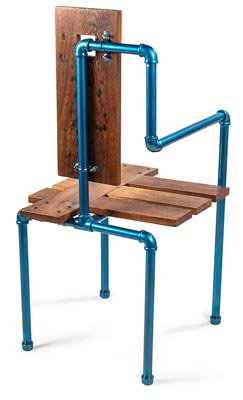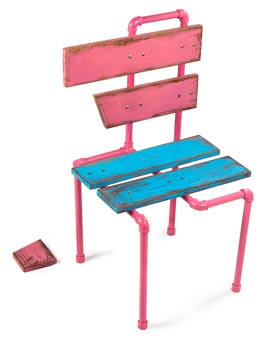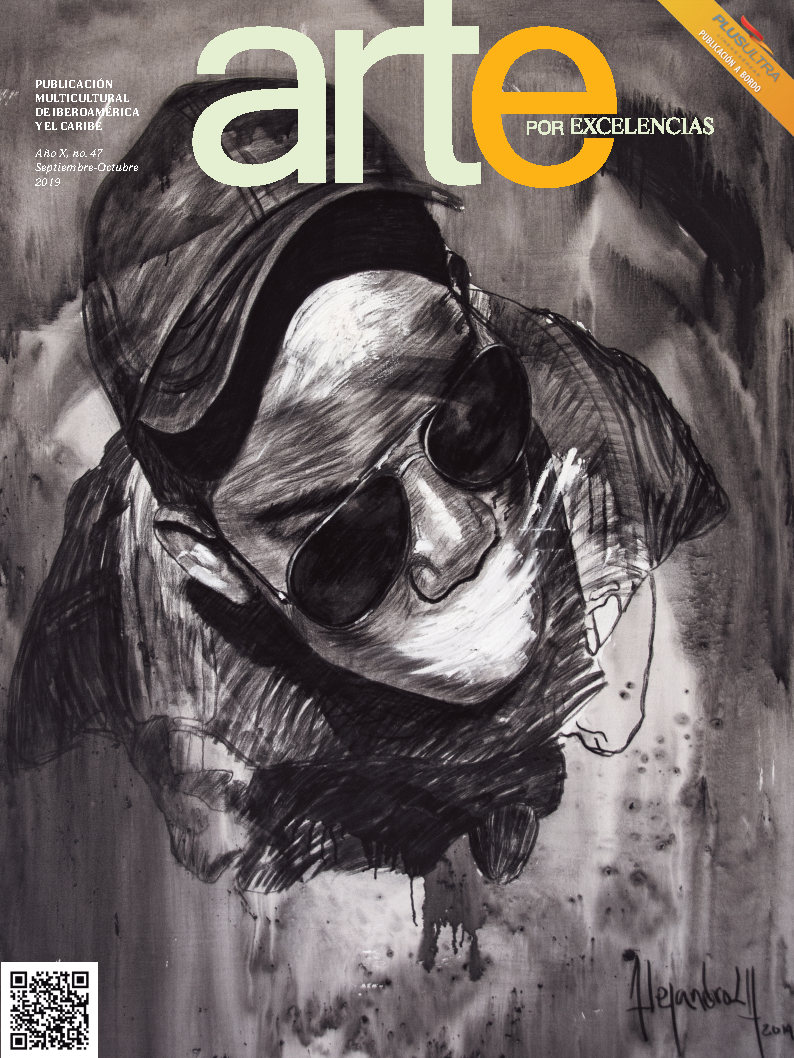"Take a chair; use it as it should be used and return it"
Franz West
From the eighties many artists and designers appealed to the resource of creating sculptural furniture or sculptures that could be considered as furniture. To go again into these constructive experiments, and raise the possibility of beauty and even the comfort from the criteria of precariousness, was the starting point of Fran Piloto, who proposes with the group of seats that makes up the azul (blue) collection a reinterpretation of the context of materials, aesthetic tastes and needs, as far as furniture is concerned, in the current every day in Cuba.
The closest antecedents could be sought in the investigations on the "architecture of the need" documented by Ernesto Oroza, and which also point to popular solutions in view of the lack of materials or objects, but not of inventive and solution capability. Without wishing to coin the phenomenon of "art of precariousness" or -closer to my personal criteria-, "Design of precariousness", it can be said that the intention of converting and transforming objects predesigned or created to be used with another function, or that they simply are obsolete and get a new function again; it is a concern of many Cuban designers.
 It may be no coincidence that in the own Old Havana exhibition atmosphere, and with less than a month apart, the Plan C team and Piloto have in common an interest in recycling materials and concepts, both to expose not only use functional objects, but also a set of ideas about the design ‘s functions and ethics, and getting that by appropriating of visual expressions considered within the discourse of contemporary art, either the photography in Piloto’s case, or the playful sculptural constructions of Plan C.}
It may be no coincidence that in the own Old Havana exhibition atmosphere, and with less than a month apart, the Plan C team and Piloto have in common an interest in recycling materials and concepts, both to expose not only use functional objects, but also a set of ideas about the design ‘s functions and ethics, and getting that by appropriating of visual expressions considered within the discourse of contemporary art, either the photography in Piloto’s case, or the playful sculptural constructions of Plan C.}
Fran Piloto proposes to use the overlapping of reading levels: first the one offered by the entry itself and its expressive capacity as an object, a second-line -also of visual character- represented by the photograph that inspires the furniture design; a third possible interpretation from the name with which is "baptized" and the suggestion from the meaning of this and the dialogue between the patronymic meaning and the symbolism of the chair color. Finally there’s a sense of total reading, where the photographed inspiration materializes in a furniture that is expressed through its name, color and combination of materials and details, which are incorporated from fragments of objects placed strategically on metal pipes support, see the ends of the front legs of July to better understand the expressive value of the details.
azul favors the materials recovery and giving new functions to obsolete parts, a project made possible after the methodical observation of the material used, the study of its functional and expressive possibilities, not in a garage, or in the industry that produces them, but from the popular talent and the use at a level almost empirical that the everyday creators make of them.
Documenting the search for solutions to the urban level, the survival in view of the material precariousness, the amendment to destruction and the city decay, was an obsession for the photographer; to create a furniture collection that would express his respect for the city in which he lives, and would show their paradigms in the design of furniture, it was the answer as a designer to this obsession. Thus the whole ethic transparency of the collection, while not intend to be the solution to the lack of design and the everyday needs, it does insist on the spiritual value of the object, which could become future productions prototype, industrial or craft, from a new interpretation of their components and materials.
Although the pieces are halfway between sculpture and functional furniture, we must not forget that they have been produced by a designer, so he has insisted on the objectivity and the usability. This view permeates the pieces, influenced by many of the vital principles of the contemporary design.
From the assembly of pipes, he uses the meaning of the water conduction as ideas conduction and from his concerns about the urban environment, so that the set of chairs represents an announcement of the country, of its economy, of the possibility of the most popular segments to access to the technologic development and the education of the population, in terms of the protection of the living spaces and the coexistence between man and his urban context.
The furniture is a testament to the way in which each individual lives, and in turn it reflects the history of a society. Although the pieces that make up the chairs collection of Piloto are not, properly, items for public consumption, if they offer a shrewd appreciation of the object life in this Cuban present.
 As designer pieces they are anchored in two fundamental resources: the materials quality -resistant even to the weather’s inclemency and the passing of time- and expressiveness of these. In this sense, it can be said that he achieves from common elements (wood and metal) a reinterpretation that escapes from the traditional use. He manages to exploit the repeated dependence of the sculptural form and uses the furniture design tradition of the last eighty years to illustrate his creative freedom, since they are not the "order" of any client, nor they depend from any industry. His proposals can afford the right that the postmodern design introduced in the past century, and respond essentially to the creator’s aesthetic identity.
As designer pieces they are anchored in two fundamental resources: the materials quality -resistant even to the weather’s inclemency and the passing of time- and expressiveness of these. In this sense, it can be said that he achieves from common elements (wood and metal) a reinterpretation that escapes from the traditional use. He manages to exploit the repeated dependence of the sculptural form and uses the furniture design tradition of the last eighty years to illustrate his creative freedom, since they are not the "order" of any client, nor they depend from any industry. His proposals can afford the right that the postmodern design introduced in the past century, and respond essentially to the creator’s aesthetic identity.
Moreover, neither does he hide the tribute to the artifact form of the “bauhasian” rationalism, or the preference for the expressive values of the industrial materials, as Piloto cites, through the popular metal pipes painted with exquisite precision, the steel tubes, the chrome plated or stainless steel, which have become key materials of the contemporary design.
The expressive and ethical value of the pieces does not place its formal virtues in the background, in each chair he has sought to draw the space, to design a competition between the spaces occupied by metal, and wood and emptiness, which is drawn from the combination of pipes and wood fragments, creating transparency areas that build geometrical shapes. It is pertinent to emphasize the importance of the empty space, because such care is given to the expression of the material as to the open space.
The artifact form does not distort the possibility of thinking about "flexible" furniture, not by the materials and the form, but by the infinite possibility of assemblies’ solutions provided by the pipes and the juxtaposition of elements very different in texture (wood and metal), a sensation that may be felt through touch and sight.
 It is perceptible the construction’s quality, well versed as a creative condition from his studies of design history and the discovery of the importance that the Art Deco, Art Nouveau or the Arts and Crafts Movement gave to this issue. Piloto is a consequent consumer of the "objectual culture" produced by artists and designers from the nineteenth century to date, -and an avid images collector-; his capacity to appreciate the form allows him to express his cultural references through the objects he designs: that way he can create cantilever sections that are placed over the pipes as a sign of innocence and lightness in Romea and Julieto, or to propose a functional, "rigid", artifact design, in the way of the poetry of the geometric rationalism in the German avant-garde (“bauhasiana”) or the Soviet design in Blas, to compensate with the color that acts as decoration, smoothing or stressing the rigid sections that draw the wood fragments.
It is perceptible the construction’s quality, well versed as a creative condition from his studies of design history and the discovery of the importance that the Art Deco, Art Nouveau or the Arts and Crafts Movement gave to this issue. Piloto is a consequent consumer of the "objectual culture" produced by artists and designers from the nineteenth century to date, -and an avid images collector-; his capacity to appreciate the form allows him to express his cultural references through the objects he designs: that way he can create cantilever sections that are placed over the pipes as a sign of innocence and lightness in Romea and Julieto, or to propose a functional, "rigid", artifact design, in the way of the poetry of the geometric rationalism in the German avant-garde (“bauhasiana”) or the Soviet design in Blas, to compensate with the color that acts as decoration, smoothing or stressing the rigid sections that draw the wood fragments.
He also appropriates of the complex “visuality” of the postmodern design of the last century’s eighties: the piping material refers to the strength, but this sensation is altered by the vulnerability and insecurity effect brought about by the bothersome perception of balance, product of the "tangled" combinations of the pipes, which suggests the state of "miraculous static" of many of the portrayed environments.
The painted and polished surfaces, and the smooth finished pipes, combined with the weakness of the wood fragments masked with an apparent precious termination, cite the combination between craft and sculpture, while still being functional and practical. These metal pipes puzzles suggest the balance between aggressiveness and sculptural poetry, they refer to the spatial awareness of a dynamic and energetic object that though artifact and geometric, is minimalist.
Closer to the reinterpretation of the baroque effect that prevails in the national preferences, he incorporates the strength of the metal supports, the organic nature of wood, the symbolic expression of color and the richness of the geometric combinations with the poetic vitality of a society made up by individuals willing to work despite all denials.
Related Publications

How Harumi Yamaguchi invented the modern woman in Japan
March 16, 2022
Giovanni Duarte and an orchestra capable of everything
August 26, 2020











